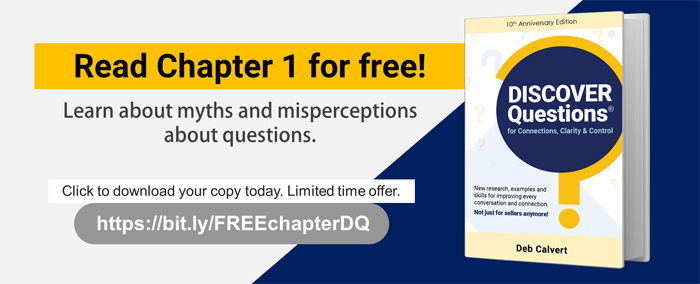What Makes a Good Question?
In Power Questions, we’re reminded that transformational historic figures like Socrates and Jesus used questions for impact. In modern times, intellectuals like Albert Einstein and Peter Drucker routinely posed provocative questions. Their abilities demonstrated that good questions are often far more powerful than answers.
“Good questions challenge your thinking. They reframe and redefine the problem. They throw cold water on our most dearly held assumptions and force us out of our traditional thinking. They motivate us to learn and discover more. They remind us of what is most important in our lives.”
These impacts aren’t possible with all questions because not all questions are created equally. Only good questions drive benefits. That begs the question: What makes a question good?
Good Questions Are:
Purposeful. You should always know the reason for asking a question. Being intentional will help you avoid meandering lines of questioning that never quite yield the desired information.
Clear. When you have clarity of purpose, you’re more likely to formulate questions that are clear. The phrasing of questions should not be subject to multiple interpretations or require guesswork about what you really mean.
Easy to understand. Simple, precise word choice conveys what you want. Don’t bog your questions down with industry jargon. Don’t assume others know all that you do about the subject. Don’t make them scramble, mentally, to understand your questions.
Concise. Oftentimes, we have a jumble of thoughts that prompt us to ask questions. When we pose a question before we sort it out, there may be extraneous information that convolutes what the question really is. A brief pause to determine your purpose and edit the question may be warranted.
Singular. Compound questions, also known to survey professionals as double-barreled, are confusing. It’s better to pose a single question and then follow up if additional information is needed. When stacking questions, you’ll get a full response to the second part and miss out on the complete answer to the first part. Stick to one topic per question. The exception to this rule is when you’re intentionally asking for a comparison or contrast.
Forthright. Embedded questions can also be confusing. An embedded question is, technically, a question that occurs as a subordinate clause rather than as the main clause in a sentence. In other words, the real question is cushioned inside unnecessary words that attempt to make the question less direct. More often, this technique diminishes the effectiveness of the question by making it closed-ended, thereby eliciting shorter and less thoughtful responses than desired.
Genuine. Under the guise of a question, you’ve probably felt backed into a corner. It sounds something like “If you really love me, why won’t you do the laundry today?” This isn’t a bona fide question. It’s manipulation. Quality questions are authentic and genuine, not laden with subtext or ulterior motives. Questions that improve connections, clarity, and control are questions that invite meaningful dialogue.
Relevant. Relative to the setting, timing, current conversation, people involved, and their current needs, quality questions are pertinent. They are directly related to matters at hand. When introducing a new topic, questions should also consider the ability of others to receive and respond in that moment.
Framed by Intent. Some questions, asked in some situations, can trigger a defensive response. To avoid misunderstandings, frame your questions by expressing your intent.
Contextual. Without a common understanding about context, misunderstandings can easily occur. Framing the intent helps prevent this. All too often, people in various functions look at problems through their own lenses and perceive questions differently. Asking “how should we address the budget shortfalls?” produces ideas about staff reductions from HR, promotional ideas from sales and marketing, and overtime control plans from production. All these hair-trigger responses may lack context. Maybe what the Board is looking for is simply the narrative for the quarterly presentation to shareholders.
Well-constructed. There are three ways to construct a question: open-ended, closed-ended, or command statement. Each of these types has validity, depending on the situation and what outcomes are desired in the conversation. The breadth of the response is influenced by the construction of your question.
According to one educator, the best questions are the ones that engage others “intellectually and emotionally, causing them to think.” In learning and problem-solving, questions should be “intellectually provocative and emotionally evocative,” advise researchers. The benefits related to asking quality questions flow from this level of engagement.
To boost your conversational effectiveness even more, follow these guidelines for creating good questions.
This is a snippet from the new book, DISCOVER Questions® for Connections, Clarity & Control, available on Amazon.

